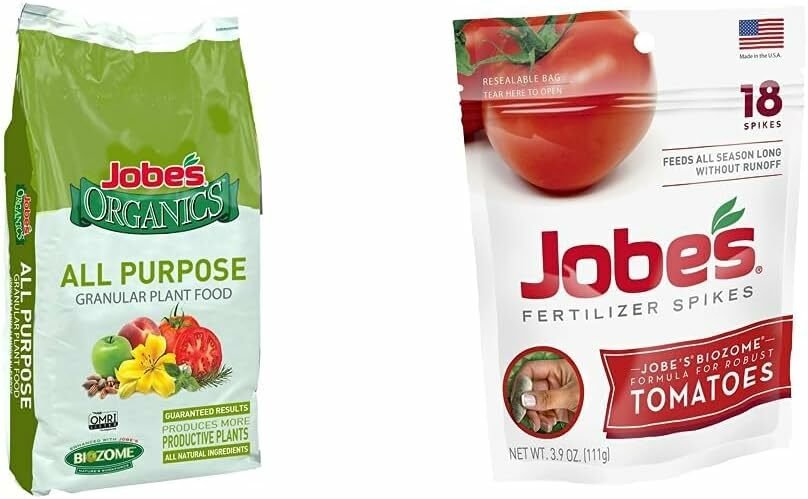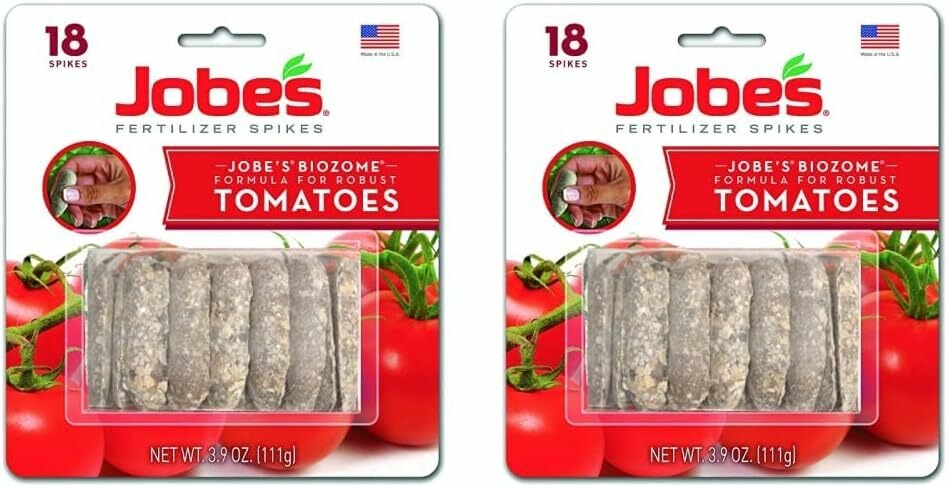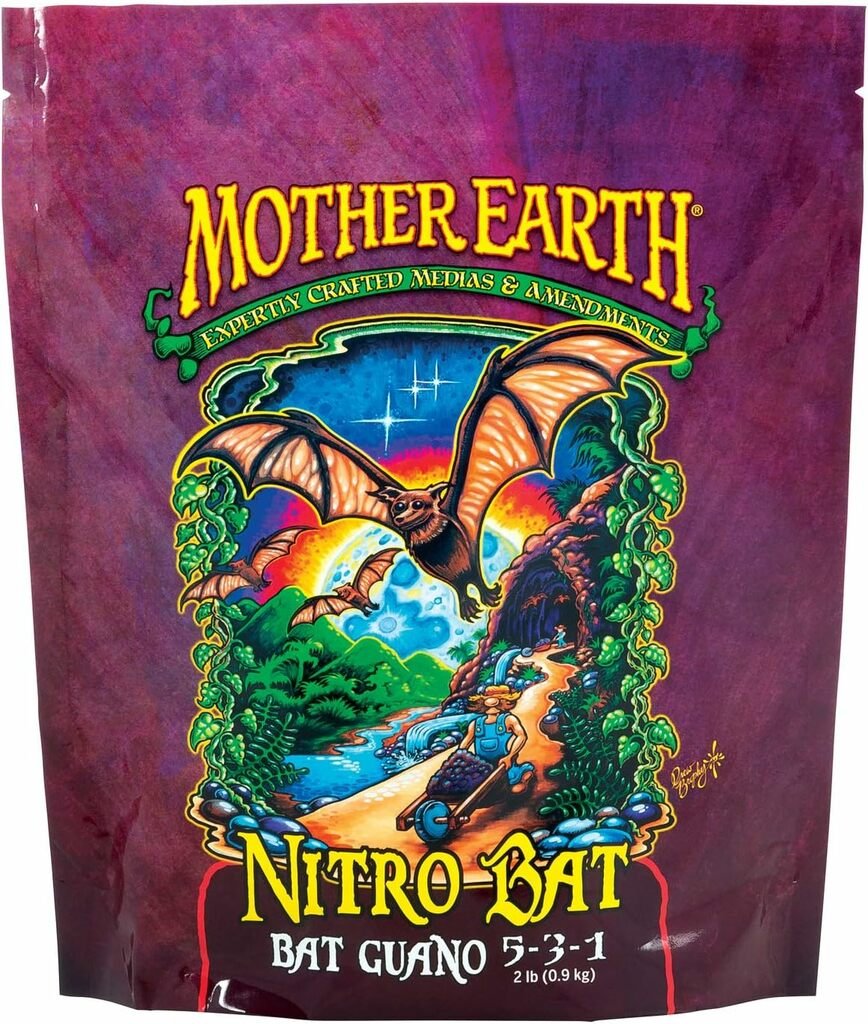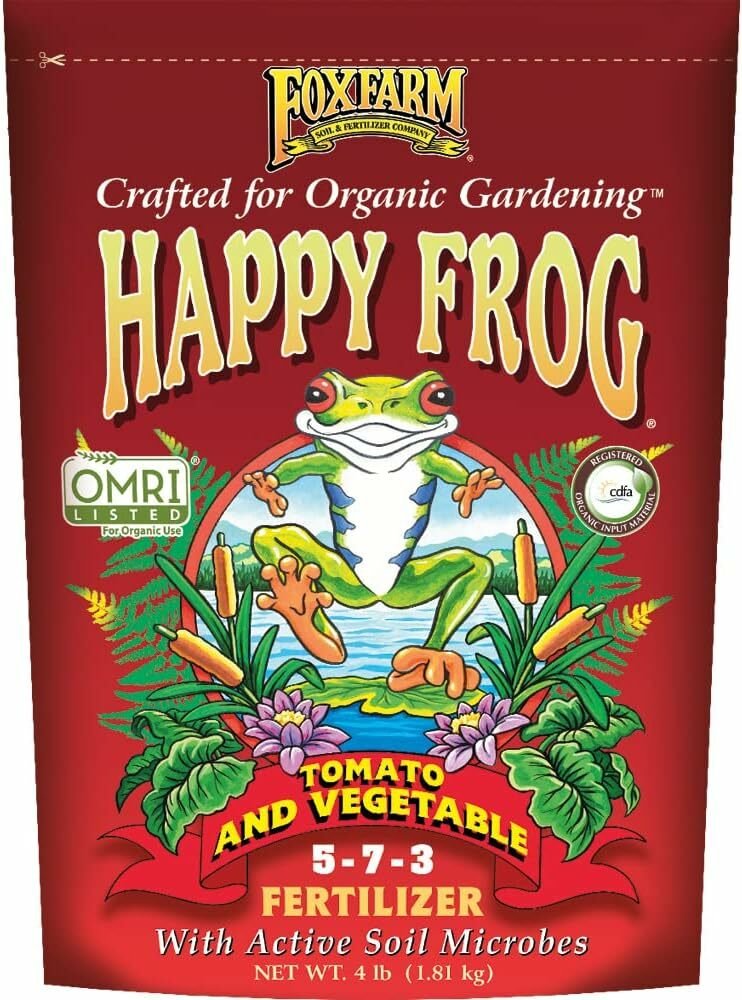Are you ready to take your tomato plants to the next level? Whether you’re a seasoned gardener or just starting, finding the best fertilizer for tomatoes can make all the difference in the world.
With 2024 on the horizon, some exciting new products designed to maximize tomato growth and yield are hitting the market.
In this comprehensive guide, we will explore the top fertilizers for tomatoes and provide you with all the information you need to make an informed decision.
From organic options to time-release formulas, we’ve got you covered. Get ready to give your tomato plants the boost they need for a bountiful harvest!
Jobe’s Organics Fertilizer

Jobe’s Organics 09524 Purpose Granular Fertilizer and Jobe’s 06005 Tomato Fertilizer Spikes are a dynamic duo for plant enthusiasts. The granular fertilizer is a true powerhouse, formulated with organic ingredients to nourish various plants, flowers, and vegetables. It is straightforward to use. Spread the granules evenly around the base of your plants and water thoroughly. The results are noticeable in just a few weeks, with plants flourishing and vibrant.
On the other hand, the tomato fertilizer spikes are designed explicitly for tomato plants, providing the perfect balance of nutrients to ensure healthy growth and maximum yield. The spikes are conveniently pre-measured, so you only have to push them into the soil near the plant’s roots. They slowly release nutrients, boosting your tomatoes for exceptional fruit production.
Both products from Jobe’s Organics are reliable and effective, delivering impressive results. They are a fantastic investment for any gardener looking to nurture their plants and maximize their yields.
OMRI listed
OMRI is listed for organic gardening
Pre-measured fertilizer spikes
Pre-measured spikes are easy to insert and leave no mess
Spikes can be difficult to insert into hard soil
Must be replaced monthly
Category: Fertilizers & Plant Food
Brand: Jobe’s Organics
Granular Fertilizer: 16 lb
Target Species: Insects
Time release: Yes
Usage: Flowers, vegetables, shrubs, trees & plants
Organic: Yes
Jobe’s Fertilizer Spikes

The Jobe’s Fertilizer 06000, Spikes, for All Tomato Plants, is a highly recommended product in the fertilizers and plant food category. Its pack of 18 spikes offers excellent value for its price. The spikes are easy to use; insert them into the soil around the tomato plants. They provide a slow release of nutrients, ensuring the plants receive a continuous supply for up to 8 weeks. Users have reported impressive results, with their tomato plants growing healthier and producing larger and tastier fruits. Overall, Jobe’s Fertilizer 06000 is a reliable and effective option for anyone looking to boost the growth of their tomato plants.
Easy to use, no mixing or measuring required
Easy to use
Slow-release design
Organic option available
No mixing or measuring
It will take a few days to start working
N-P-K ratio is too low
Weight: 7.4 ounces
Use: Continuous nourishment
Package: 18 spikes
Fertilizer analysis: (6-18-6)
Product type: Sticks
Plants: All Tomato
Mother Earth HGC733955 Nitro Bat Fertilizer

The Mother Earth Products HGC733955 Nitro Bat Bat Guano 5-3-1 Plant Fertilizer is an impressive product for vegetative plants, flowers, and tomatoes. Its natural formula and 5-3-1 nutrient ratio provide the necessary nourishment to promote healthy growth. The 2 lbs. packaging is convenient and easy to handle.
This fertilizer is highly effective and provides noticeable results. It is easy to apply and does not require much effort. The Mother Earth brand is known for its quality products, and this fertilizer lives up to that reputation. Overall, this product is an excellent investment for any gardener or plant enthusiast looking to boost their plant’s growth and health.
Good for gardens and raised beds
Good for use on all-natural plants
OMRI Listed for organic gardening
Good for flowering plants
Slow-release, non-burning formula
Strong odor
Gender: Unisex-Adult
Size: 8 x 5.5 x 12.25 inches
Weight: 2 pounds
Uses: Hydroponic, Soil, Coco, Raised beds, Pots, Inground
Feature: Good source of nitrogen and phosphorus
Mother Earth Season’s Choice Fertilizer

The Mother Earth Season’s Choice Tomato & Vegetable Mix suits avid gardeners. As someone constantly trying to improve their vegetable garden, I think this fertilizer has exceeded all expectations.
Not only does it provide essential nutrients to my plants, but it also promotes healthy growth and improves overall plant health. The 4.4 lb bag is more than enough to cover a significant portion of my garden, making it a cost-effective option.
Whether you’re a beginner or a seasoned gardener, I highly recommend the Mother Earth Season’s Choice Tomato & Vegetable Mix for its outstanding results.
Ideal for all varieties of vegetable plants
OMRI-listed for organic gardening
The quick-release formula can lead to nutrient burn
Must be mixed into soil for best results
Weight: 4.64 pounds
Size: 8 x 5.5 x 12.25 inches
Type: Garden Fertilizer
For: Unisex-Adult
Product form: Granular
Brand: Mother Earth
FoxFarm Happy Frog Garden Soil

The FoxFarm Happy Frog Garden Tomato and Vegetable Soil Dry Plant Fertilizer Mix is a top-notch product for anyone looking to boost the growth of their outdoor plants and gardens.
This 4-pound bag of organic plant fertilizer mix is designed to provide the essential nutrients for healthy and vibrant tomato and vegetable plants.
With its high-quality ingredients, this product ensures optimal plant care and growth. The fertilizer mix is easy to use and can be applied directly to the soil, making it suitable for beginner and experienced gardeners. It is an excellent option for those who prefer organic gardening, as it is free from harmful chemicals and pesticides.
The FoxFarm brand is renowned for its commitment to producing high-quality fertilizers, and this product lives up to its reputation. Overall, the FoxFarm Happy Frog Garden Tomato and Vegetable Soil Dry Plant Fertilizer Mix is a must-have for gardeners who want to see their plants thrive.
OMRI is listed for organic gardening
Encourages healthy plants
Organic, all-natural ingredients
The product has a strong odor from the bag
May attract bugs due to a mix of organic materials
Weight: 4 Pound
Type: Powder
Organic: Yes
Usage: Tomato and Vegetable
Size: 4 Pound Bag
Function: Disease prevention, beautiful growth
FAQ
When Should You Start Fertilizing Tomatoes?
Fertilizing tomatoes at the correct time ensures healthy growth and a bountiful harvest. Here’s when and how to start fertilizing your tomato plants:
Timing for Fertilization
- After Transplanting or Root Establishment: Begin fertilizing your tomato plants approximately two to three weeks after transplanting them into the garden or once they have established a strong root system.
Selecting the Right Fertilizer
- Choose a Tomato-Specific Fertilizer: Opt for a fertilizer specifically formulated for tomatoes, as they have unique nutrient requirements compared to other vegetables.
- Balanced Nutrients: Look for a fertilizer with a balanced ratio of nitrogen, phosphorus, and potassium (N-P-K). Nitrogen promotes leaf growth, phosphorus supports root development, and potassium enhances fruit production.
Application Guidelines
- Follow Recommended Rates: Adhere to the recommended application rates specified on the fertilizer packaging to avoid over-fertilizing, which can lead to excessive foliage growth at the expense of fruit production.
- Even Application: Apply the fertilizer evenly around the base of the tomato plants, avoiding direct contact with the stems to prevent potential burning.
Maintenance Throughout the Growing Season
- Regular Fertilization: Tomato plants are heavy feeders and require regular fertilization throughout the growing season to maintain optimal growth and productivity.
- Monitor for Nutrient Deficiencies: Monitor your tomato plants for any signs of nutrient deficiencies, such as yellowing leaves or stunted growth, and adjust your fertilization schedule as needed.
By starting to fertilize your tomato plants after they have been transplanted or have established a strong root system, using a balanced tomato-specific fertilizer, and following proper application guidelines, you can provide your plants with the essential nutrients they need to thrive. With diligent care and attention to their nutritional needs, you’ll be rewarded with a plentiful harvest of delicious homegrown tomatoes.
How Often Should I Fertilize My Tomatoes?
Determining the frequency of fertilizing your tomatoes involves several considerations to ensure optimal growth and yield. Here’s a guide to help you decide how often to fertilize your tomato plants:
Factors Influencing Fertilization Frequency
1. Soil Quality
- Assess the nutrient content and composition of your soil. Poor-quality soil may require more frequent fertilization to supplement essential nutrients.
2. Weather Conditions
- Consider factors such as rainfall and temperature fluctuations, as they can affect nutrient availability in the soil. Plants may require more frequent fertilization during heavy rain or extreme heat.
3. Plant Growth Stage
- Adjust the fertilization frequency based on the growth stage of your tomato plants. Young seedlings and newly transplanted tomatoes may benefit from more frequent fertilization to support vigorous root and foliage development.
Recommended Fertilization Schedule
- Every Two to Three Weeks: As a general guideline, fertilize your tomato plants every two to three weeks during the growing season.
- This interval provides a consistent supply of nutrients to support healthy plant growth and fruit production.
Choosing the Right Fertilizer
- Balanced Fertilizer: Select a fertilizer with balanced nitrogen, phosphorus, and potassium (N-P-K) levels to provide essential nutrients for robust plant development.
- A balanced fertilizer ensures that your tomato plants receive a well-rounded nutrient blend to thrive.
Monitoring and Adjustments
- Plant Health: Regularly monitor the health and growth of your tomato plants for any signs of nutrient deficiencies or over-fertilization.
- Adjust your fertilization schedule as needed based on the specific requirements of your plants and environmental conditions.
In conclusion, fertilizing your tomato plants every two to three weeks with a balanced fertilizer is generally recommended to promote healthy growth and maximize fruit yield. However, factors such as soil quality, weather conditions, and plant growth stage should be considered when determining the frequency of fertilization.
By monitoring your plants closely and adjusting your fertilization schedule accordingly, you can ensure that your tomato plants receive the nutrients they need to thrive and produce a bountiful harvest of delicious tomatoes.
How Much Fertilizer Do Tomatoes Need?
Determining the appropriate amount of tomato fertilizer is essential for promoting healthy growth and maximizing yield. Here’s a comprehensive guide to help you calculate the right amount of fertilizer for your tomato plants:
Factors Influencing Fertilizer Requirement
1. Soil Nutrient Content
- Conduct a soil test before planting to assess nutrient levels and pH.
- Soil test results will guide you in selecting the appropriate fertilizer formulation and determining the specific nutrient requirements of your tomato plants.
2. Fertilizer Formulation
- Choose a balanced fertilizer with a higher phosphorus content to promote root and flower development.
- Opt for formulations such as 10-10-10 or 14-14-14, which provide a balanced mix of nitrogen, phosphorus, and potassium.
Calculating Fertilizer Application
- Determine Planting Area: Measure the total square footage of the area where you will plant tomatoes.
- Recommended Application Rate: Use a general guideline of 1-2 pounds of balanced fertilizer per 100 square feet of planting area.
- Divide into Multiple Applications: Split the total fertilizer needed into multiple applications throughout the growing season.
- This helps prevent nutrient burn and ensures a steady supply of plant nutrients.
Monitoring and Adjustments
- Observe Plant Growth: Regularly monitor the growth and health of your tomato plants throughout the growing season.
- Adjust fertilizer application rates based on plant performance and any signs of nutrient deficiencies or over-fertilization.
- Environmental Factors: Consider ecological factors such as rainfall and soil type, as they can affect nutrient availability and plant nutrient requirements.
Understanding the nutrient needs of tomatoes and calculating the appropriate amount of fertilizer is essential for achieving a successful harvest. Conducting a soil test, selecting the proper fertilizer formulation, and dividing the total amount into multiple applications will help maintain optimal nutrient levels and promote healthy plant growth.
By monitoring plant performance and adjusting as needed, you can ensure that your tomato plants receive the nutrients they need to thrive and produce abundant, high-quality fruit. Remember to strike a balance and avoid over-fertilizing to prevent potential adverse effects on plant health.
Organic vs. Synthetic Fertilizers
When deciding between organic and synthetic fertilizers for your tomato plants, it’s essential to understand the characteristics, advantages, and disadvantages of each option. Here’s a comparison to help you make an informed choice:
Organic Fertilizers
- Derived from Natural Sources: Organic fertilizers are made from natural materials such as compost, manure, and bone meal.
- Rich in Organic Matter: They contain organic matter that improves soil structure, promotes microbial activity, and enhances soil fertility.
- Slow Release of Nutrients: Organic fertilizers release nutrients gradually, providing a sustained supply to plants and reducing the risk of nutrient leaching.
- Environmentally Friendly: They have a lower risk of soil damage and nutrient runoff, making them environmentally sustainable options.
Synthetic Fertilizers
- Manufactured Chemical Compounds: Synthetic fertilizers are chemically formulated to deliver specific nutrients in readily available forms.
- Quick-Acting: They provide an immediate nutrient boost to plants, promoting rapid growth and development.
- Specific Nutrient Formulations: Synthetic fertilizers can be tailored to meet the particular nutritional needs of plants, ensuring optimal growth and productivity.
- Widely Available and Cost-Effective: They are often less expensive and more readily available than organic fertilizers, making them a convenient option for many gardeners.
Choosing the Best Fertilizer for Tomatoes
- Consider Soil Conditions: Assess your garden’s nutrient levels and soil structure before selecting a fertilizer.
- Environmental Impact: Evaluate the environmental impact of both organic and synthetic fertilizers, considering factors such as soil health, water quality, and sustainability.
- Personal Preference: Your gardening philosophy and priorities will influence your choice between organic and synthetic fertilizers.
- Combining Options: Some gardeners combine organic and synthetic fertilizers to reap the benefits of both approaches, such as long-term soil improvement and immediate nutrient availability.
Conclusion
The best fertilizer for tomatoes depends on various factors, including soil conditions, environmental considerations, and personal preferences. Both organic and synthetic fertilizers have advantages and disadvantages, so it’s essential to weigh these factors carefully before deciding.
Ultimately, the health and productivity of your tomato plants will benefit from a balanced approach that considers both the nutritional needs of the plants and the long-term sustainability of your garden. Whether you choose organic, synthetic, or a combination of both, the key is to provide your tomatoes with the nutrients they need to thrive while minimizing environmental impact.
Author
-

Anne Williams is a passionate wordsmith, blending creativity with expertise in SEO to craft captivating content. With a penchant for concise yet compelling prose, she brings stories to life and leaves readers craving more. When she's not penning her next masterpiece, you can find her exploring new coffee shops or lost in the pages of a good book.
View all posts






